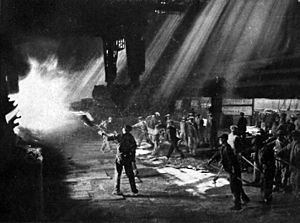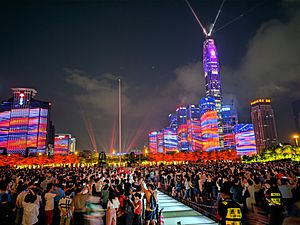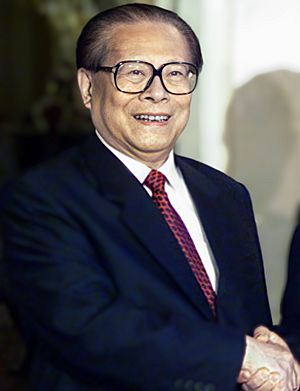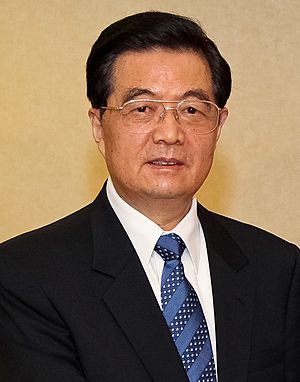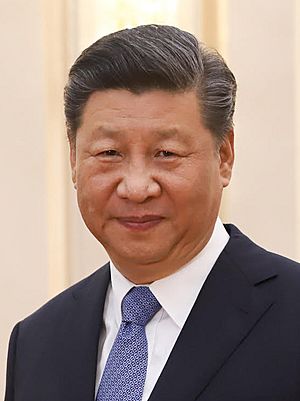History of the People's Republic of China facts for kids
The history of the People's Republic of China tells the story of mainland China since October 1, 1949. On that day, Mao Zedong, leader of the Chinese Communist Party (CCP), announced the creation of the People's Republic of China (PRC). This happened after the CCP won most of the Chinese Civil War. The PRC is the newest government to rule mainland China. Before it came the Republic of China (1912–1949) and thousands of years of emperor-led dynasties.
Important leaders of the PRC have included Mao Zedong (1949-1976), Deng Xiaoping (1978-1989), Jiang Zemin (1989-2002), Hu Jintao (2002-2012), and Xi Jinping (2012-present).
The idea for the People's Republic began with the Chinese Soviet Republic in 1931. This was supported by the Soviet Union during the civil war against the Nationalist government.
Under Mao, China changed from a farming society to a socialist one. It focused on heavy industries and a planned economy. Big campaigns like the Great Leap Forward and the Cultural Revolution caused many problems. After 1978, Deng Xiaoping started economic reforms. These changes helped China become the world's second-largest economy. It became known for its factories and high-tech leadership.
China first got help from the USSR in the 1950s. But then they became rivals until 1989. In the 21st century, China's new wealth and technology led to competition with India, Japan, and the United States. Since 2017, there has been a growing trade war with the United States.
Contents
The Mao Era (1949–1976)
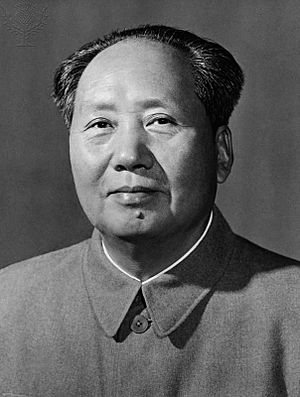
China's Big Changes
After the Chinese Civil War, Mao Zedong and his Communist forces won. The previous leader, Chiang Kai-shek, went to Taiwan. Mao then announced the founding of the People's Republic of China on October 1, 1949. Mao believed in a government-controlled economy and class struggle. He ruled as a strong leader.
After the Korean War ended in 1953, Mao started campaigns against former landlords and merchants. He also began a plan to make China more industrial. Mao's first goal was to change how land was owned. He started land reforms, which included executing many powerful landlords. China's old system, where rich landowners had most of the farmland, was replaced. Land was given to poor or landless farmers. This greatly reduced the difference between rich and poor. Over a million landlords were executed during these land reforms. In some villages, most "landlords" lost their land and sometimes their lives. All farmers who had no land before now received some. This meant that "middling peasants" made up 90% of the village and owned 91% of the land. Foreign businesses were taken over, and foreigners were asked to leave.
At the same time, political movements began across the country. The Anti-Rightist Campaign of 1957–1958 harmed democracy in China. During this time, at least 550,000 people were punished. Most of them were thinkers and people who disagreed with the government. After this campaign, China became a one-party state ruled by the Chinese Communist Party. Other big political movements in the 1950s included the Suppression of Counter-revolutionaries and the Three-anti and Five-anti Campaigns. Each of these led to many deaths.
The Great Leap Forward and Its Results
Mao Zedong believed that socialism would win over all other ideas. After a first five-year plan that copied the Soviet Union's economy, Mao started the Great Leap Forward in 1958. This was a huge project to organize farms into collective farms called People's Communes. Mao encouraged people to use small, community-run furnaces to make more steel. Workers were taken away from farm work to make steel. This meant that many crops were left to rot in the fields. Mao decided to continue these furnaces even after he saw that good steel could only be made in factories. He thought stopping the program would make farmers less excited about his plan.
The ideas of Maoism in China may have caused the deadliest famine in human history. Between 15 and 55 million people died from hunger and diseases. By the end of 1961, the number of babies born was almost cut in half because of poor nutrition. In 1958, the Xunhua uprising happened. In 1959, a big uprising started in Tibet. Tens of thousands of Tibetans died, and the Dalai Lama left the country.
Mao's failure with the Great Leap Forward reduced his power in the government. President Liu Shaoqi and Deng Xiaoping took over many daily tasks. This happened especially after the Seven Thousand Cadres Conference in 1962. A power struggle began between Mao Zedong and Liu Shaoqi and Deng Xiaoping after 1962. As a result, Mao launched the Socialist Education Movement from 1963 to 1965.
A more successful program was the "Two Bombs, One Satellite" project, started in 1958 with help from Moscow. It used top scientists who returned to China, like Qian Xuesen. China successfully developed its first atomic bomb, nuclear missile, hydrogen bomb, and artificial satellite by 1970. However, this program was also affected by the Great Leap Forward and the Cultural Revolution.
The Cultural Revolution
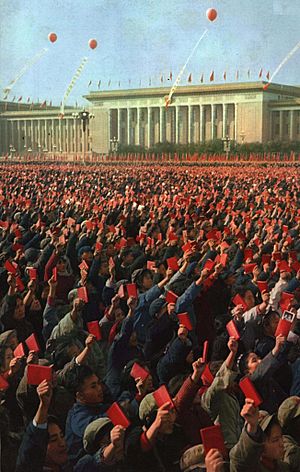
In 1963, Mao Zedong started the Socialist Education Movement. This is seen as a step towards the Cultural Revolution. To make sure everyone followed socialist ideas and to get rid of "old ways of thinking", Mao began the Cultural Revolution in May 1966. He wanted to regain political power in China. This campaign affected every part of Chinese life. The number of deaths is estimated to be from hundreds of thousands to 20 million. Mass killings happened across the country. There were even reports of cannibalism. Red Guards caused fear in the streets. Many ordinary people were called "counter-revolutionaries." Education and public transport almost stopped. Daily life involved shouting slogans and reading Mao's quotes. Many important political leaders, including Liu Shaoqi and Deng Xiaoping, were removed from power. They were called "capitalist roaders." The campaign did not fully end until Mao Zedong's death and the arrest of the Gang of Four in 1976. The second constitution of China, the "1975 Constitution", was approved in 1975 during the Cultural Revolution.
However, by the time Mao died, China's unity and independence were secure for the first time in a century. There was also progress in infrastructure, industry, healthcare, and education. Only 20% of people could read in 1949, but 30 years later, 65.5% could. This improved the standard of living for average Chinese people. Some argue that campaigns like the Great Leap Forward and the Cultural Revolution helped China develop faster. Even though they caused economic and human disaster, they created a "clean slate" for future economic progress.
China's Foreign Relations
The main foreign policy goal was to be recognized by other countries, despite strong opposition from the United States. In 1964, France became the first major Western country to open relations with China.
Relations with India
In 1950, India was one of the first countries to recognize the People's Republic of China. It also set up official diplomatic ties. However, India was close to the USSR. In 1962, a one-month Sino-Indian war broke out along their remote border. Another conflict happened in 1967. Border tensions have continued from time to time since then.
Relations with the Soviet Union
Beijing was happy that the Soviet Union was successful in the Space Race. The original Sputniks showed that the communist movement was catching up in technology with the Americans. Mao thought the Soviets now had a military advantage and should increase the Cold War. But Khrushchev knew the Americans were far ahead in military space technology.
Problems grew, quickly ending the 1950 alliance. This destroyed the unity of the socialist countries and affected the world's balance of power. The split began with Nikita Khrushchev's plan to move away from Stalin's policies. This angered Mao, who admired Stalin. Moscow and Beijing became rivals around the world. Communist parties everywhere had to choose sides. Many of them split, with pro-Soviet communists fighting pro-Chinese communists for control of left-wing groups.
Inside China, the Sino-Soviet split encouraged Mao to start the Cultural Revolution. He wanted to remove any signs of Russian ways of thinking. Mao argued that if there was a nuclear war, humanity would not be destroyed. Instead, a new communist world would rise from the ruins of imperialism. This worried Moscow, which had a more realistic view of the terrible results of a nuclear war.
Three big issues caused problems between the two nations: Taiwan, India, and China's Great Leap Forward. Moscow supported Beijing's claim that Taiwan belonged to China. But it wanted to be warned if China planned an invasion that might bring American involvement. Beijing refused. The Chinese bombing of the island of Quemoy in August 1958 increased tensions. Moscow was also building ties with India, selling weapons and seeing it as a key ally. However, China was threatening India's northern borders, especially from Tibet. China was building a military road system that would reach disputed border areas. The Russians clearly favored India, and Beijing saw this as a betrayal.
The biggest ideological issue was the Great Leap Forward. This showed China rejecting the Soviet way of economic development. Moscow was very upset, especially since it had spent a lot to give China high-tech help, including some nuclear knowledge. Moscow pulled out its much-needed technicians and stopped economic and military aid. Khrushchev became very rude, making fun of China and Mao Zedong to both communist and international audiences. Beijing responded by saying Moscow was not truly following Lenin's ideas. Beijing insisted it was the true follower of Lenin. At one big meeting of communist parties, Khrushchev personally attacked Mao. He called him an extreme leftist and compared him to Stalin for being dangerously self-centered. The conflict was now out of control. It was fought out among 81 communist parties worldwide. The final split came in July 1963. This happened after 50,000 refugees escaped from Xinjiang in western China to Soviet land to avoid being persecuted. China made fun of Russia's mistakes in the Cuban Missile Crisis of 1962. It called their actions "adventurism" at first and then "giving up" when they lost. Moscow now focused more on friendly ties and test ban treaties with the United States and United Kingdom.
Beijing increasingly saw the Soviet Union as its biggest threat. It saw the USSR as "Social imperialism". This was even more threatening than the leading capitalist power, the United States. Because of this, China and the United States started to make friendly moves. Examples include the Ping Pong Diplomacy, Panda Diplomacy, and President Nixon's visit to China in 1972.
New Diplomatic Ties
China officially started relationships with several major Western countries and Japan. Usually, these countries then ended their ties with the government on Taiwan.
- In January 1964, China started official diplomatic relations with France.
- In October 1970, China started official diplomatic relations with Canada.
- In November 1970, China started official diplomatic relations with Italy.
- In 1971, the United Nations voted to recognize the People's Republic of China. This meant China replaced the Republic of China (Taiwan) in the UN.
- In March 1972, China started official diplomatic relations with the United Kingdom. The UK was the first major Western country to recognize the PRC in 1950.
- In September 1972, China started official diplomatic relations with Japan.
- In October 1972, China started official diplomatic relations with West Germany.
- In December 1972, China started official diplomatic relations with Australia.
- In March 1973, China started official diplomatic relations with Spain.
Major Disasters of the Mao Era
| Time | Disaster | Location | Deaths | Descriptions |
|---|---|---|---|---|
| 1950 | Assam–Tibet earthquake | Tibet | 4,000 | Around 4000 people died in Tibet, while over 1000 died in India. |
| 1954 | Yangtze floods | Yangtze River | 33,000 | Mostly in Hubei province. |
| 1957-1958 | Asian flu | Worldwide | This flu started in Guizhou, southern China. It killed 1–4 million people worldwide. | |
| 1959-1961 | Great Chinese Famine | Nationwide | 15-55 million | Mainly caused by the Great Leap Forward. |
| 1966 | Xingtai earthquake | Hebei | 8,064 | A strong earthquake with a magnitude of 6.8. |
| 1968-1969 | Hong Kong flu | Worldwide | This flu started in British Hong Kong. It killed 1–4 million people worldwide. | |
| 1970 | Tonghai earthquake | Yunnan | Over 10,000 | A strong earthquake with a magnitude of 7.1. The government did not widely publicize it for over a decade. |
| 1975 | Haicheng earthquake | Liaoning | 1,328 | A magnitude 7.5 earthquake. Some sources claim 2,041 deaths. |
| 1975 | The Banqiao Dam failure | Henan | 85,600-240,000 | 62 dams, including the large Banqiao Dam, collapsed due to Typhoon Nina. This caused one of the biggest floods in history. Many of these dams were built with Soviet help or during the Great Leap Forward. |
| 1976 | Tangshan earthquake | Hebei | At least 242,769 | A very strong earthquake with a magnitude of 7.6. |
Deng Xiaoping's Era of Change (1976–1989)
A Time of Transition
After Mao Zedong died, there was a power struggle. The main people involved were the Gang of Four, Hua Guofeng, and finally Deng Xiaoping. China's third constitution, the "1978 Constitution", was approved in 1978 under Hua's leadership.
In December 1978, with support from other high-ranking officials, Deng took over from Hua. He became the top leader of China. This happened during an important meeting of the Communist Party. Deng's allies, like Hu Yaobang and Zhao Ziyang, also gained more power.
Changing the Cultural Revolution's Impact
In September 1977, Deng first suggested the idea of "Boluan Fanzheng". This meant correcting the mistakes of the past. He wanted to undo the extreme policies of the Cultural Revolution. In the same year, he brought back the National College Entrance Examination. This exam had been canceled for ten years because of the Cultural Revolution. Also, over several years, Deng and his allies helped more than 3 million people who had been wrongly accused or punished. However, when it came to Mao's legacy, Deng said Mao was "7 parts good, 3 parts bad." He avoided completely criticizing Mao.
In June 1981, the Chinese government officially condemned the Cultural Revolution. It was called "a domestic havoc" and "the most severe setback" for socialism since 1949. But the government also said that "Comrade Mao Zedong was a great Marxist." It stated that his contributions to the Chinese revolution were much greater than his mistakes. Today, public opinion of Mao has improved. Pictures of Mao and items related to him have become popular.
After the Cultural Revolution, public safety across the country got worse in the late 1970s and early 1980s. As a result, Deng launched the ""Strike Hard" Anti-crime Campaign" in 1983. This campaign lasted until early 1987. More than 1.7 million people were arrested and punished during this time.
Reforms and Opening Up

At a key meeting of the Communist Party, Deng started China on the path of "Reform and Opening-up" (Gaige Kaifang). These policies began by allowing farmers to work their own land again. Then came industrial reforms that reduced government control over factories. In 1979, Deng focused on "Four Modernizations" for China. He also introduced the idea of "xiaokang," meaning a "moderately prosperous society." Deng believed that light industry should develop first, before heavy industries.
The success of Lee Kuan Yew in making Singapore an economic powerhouse greatly influenced China's leaders. Under Deng Xiaoping, China made a big effort to copy Singapore's policies. These included economic growth, encouraging new businesses, and quietly stopping disagreement. Over the years, more than 22,000 Chinese officials went to Singapore to learn its methods.
Deng strongly supported the idea of Special Economic Zones (SEZs). These included cities like Shenzhen, Zhuhai, and Xiamen. In these areas, foreign money could be invested without strict government rules. They basically ran on a capitalist system. On January 31, 1979, the Shekou Industrial Zone in Shenzhen was created. It was the first area in China to "open up." Under the leadership of Yuan Geng, the "Shekou model" of development grew. Its famous slogan was "Time is Money, Efficiency is Life." This idea then spread to other parts of China.
In January 1984, Deng Xiaoping visited Shenzhen and Zhuhai. He praised the "Shenzhen Speed" of development and the success of the SEZs. With Yuan Geng's help, China's first joint-stock bank, the China Merchants Bank, and first joint-stock insurance company, the Ping An Insurance, were both set up in Shekou. In May 1984, fourteen coastal cities, including Shanghai, Guangzhou, and Tianjin, were named "Open Coastal Cities."
Deng understood how important science and technology were for the "Four Modernizations." He said that "science and technology are the primary productive force." In December 1981, he approved building the "Beijing Electron–Positron Collider." This was China's first high-energy particle collider. He also met with Nobel Prize winner Tsung-Dao Lee, who supported the project. In 1985, the Great Wall Station, China's first research station in Antarctica, was built. In 1986, Deng approved the "863 Program" proposed by four leading Chinese scientists. In the same year, a nine-year compulsory education system was made law. In the 1980s, the Qinshan Nuclear Power Plant in Zhejiang and the Daya Bay Nuclear Power Plant in Shenzhen were built. These were China's first two nuclear power plants. Deng also allowed foreign experts to work in China, including the famous Chinese-American mathematician Shiing-Shen Chern.
People who support the economic reforms point to many successes. These include fast growth in consumer goods and exports. They also mention the rise of an urban middle class (now 15% of the population). Living standards improved greatly, shown by big increases in GDP per person, spending, life expectancy, literacy rate, and grain production. There are also more personal rights and freedoms for average Chinese people.
Critics of the reforms, both in China and abroad, say they caused problems. These include big differences in wealth, environmental pollution, widespread corruption, and high unemployment from closing inefficient state-owned businesses. They also say the reforms brought unwelcome cultural influences. They believe China's culture has been harmed. They also think the poor have become a hopeless underclass, and that social stability is at risk. They also feel that political reforms, like moves towards popular elections, were stopped unfairly.
However, the path of modernization and market-focused economic reforms that China started in the early 1980s seems to be largely accepted. Even critics of China's market reforms do not want to go back to the old ways. Instead, they suggest ways to fix some of the social problems caused by the reforms. In 1979, the Chinese government started a one child policy to control its fast-growing population. This policy, which caused some controversy, led to a big drop in child poverty. The law was ended in 2015.
Political Reforms

On August 18, 1980, Deng Xiaoping gave a speech about reforming the Party and state leadership system. This started political reforms in China. He called for an end to too much bureaucracy and power in one place. He suggested term limits for top positions and supported "democratic centralism" and "collective leadership." Deng also asked the National People's Congress to revise China's constitution. He stressed that the constitution must protect citizens' civil rights and show the idea of separation of powers. He also described "collective leadership" and supported "one man, one vote" among leaders to avoid dictatorship. In December 1982, China's fourth constitution, the "1982 Constitution", was approved. It included Chinese-style constitutionalism and much of it is still in use today.
In the first half of 1986, Deng again called for political reforms. Further economic reforms were being held back by the old political system. The country also saw more corruption and economic inequality. This was made worse by the many special benefits enjoyed by government officials and their families. A group of five people was set up in September 1986 to research China's political reforms. Deng wanted political reforms to make the government work better. He also wanted to separate the responsibilities of the Communist Party and the government. He aimed to get rid of bureaucracy. Although he also mentioned "rule of law" and "democracy", Deng limited the reforms to the one-party system. He was against using Western-style constitutionalism.
In October 1987, at a Party meeting led by Deng, Zhao Ziyang gave an important speech about political reforms. In his speech, Zhao said that socialism in China was still in its early stage. Following Deng's ideas from 1980, Zhao listed many steps for political reforms. These included promoting the rule of law, separating powers, and improving the election system. At this meeting, Zhao was elected as the new General Secretary of the Party.
However, after the 1989 Tiananmen Square protests and massacre, many leading reformers like Zhao were removed from their jobs. Most of the planned political reforms (after 1986) ended suddenly. Conservative leaders took control until Deng Xiaoping's southern tour in early 1992. On the other hand, many policies from the political reforms Deng started in the early 1980s are still in effect after 1989. These include the new Constitution, term limits, and democratic centralism. However, some of these have been changed by leader Xi Jinping after 2012.
Political Turmoil

In 1983, conservative leaders started the "Anti-Spiritual Pollution Campaign."
In 1986, student protests led to the resignation of Hu Yaobang. He was the Party's General Secretary and a leading reformer. Conservatives then launched the "Anti-Bourgeois Liberalisation Campaign." This campaign ended in mid-1987 because Zhao Ziyang convinced Deng Xiaoping that conservatives were using it to oppose the "Reforms and Opening-up" program.
Even though living standards improved a lot in the 1980s, Deng's reforms had critics. Hard-liners said Deng allowed social problems back into China. They also saw an increase in materialistic thinking. Liberals, however, criticized Deng's firm stance against wider political reforms. Liberal groups began to protest against the Party's strict rule. In 1989, the death of Hu Yaobang, a liberal figure, sparked weeks of protests in Tiananmen Square. The government declared martial law and sent in tanks and soldiers to stop the demonstrations. Western countries and international organizations briefly stopped their official ties with China's government.
Military Modernization
In early 1979, China fought a one-month war with Vietnam. China also continued to support the Khmer Rouge in Cambodia. This was done with the United States, Thailand, and other countries to counter the Soviet Union's influence in the region.
In March 1981, Deng Xiaoping decided that the People's Liberation Army (PLA) needed a military exercise. In September 1981, the North China Military Exercise took place. It was the largest exercise by the PLA since the founding of the People's Republic.
In 1985, to modernize the PLA and save money, Deng cut 1 million troops from the military. He also ordered further modernization.
Foreign Relations
On January 1, 1979, the People's Republic of China officially started diplomatic relations with the United States. In January 1979, Deng Xiaoping visited the United States. This was the first official visit by a top Chinese leader to the US. In the same year, the Chinese Olympic Committee for China was recognized by the International Olympic Committee.
Following advice from Lee Kuan Yew, Deng Xiaoping agreed to open up the country more. He also stopped spreading communist ideas and revolutions to other countries, unlike Mao. These decisions greatly improved relations between China and many countries, especially in Southeast Asia.
In 1984, Xu Haifeng, a pistol shooter, won China's first Olympic gold medal at the 1984 Summer Olympics in Los Angeles. In the same year, China and the United Kingdom signed the Sino-British Joint Declaration. This agreement stated that Hong Kong would be returned to China on July 1, 1997. It would operate under the "one country, two systems" framework. In 1987, China and Portugal signed a similar agreement for Macau. Macau would be returned to China on December 20, 1999, also under "one country, two systems."
In 1989, relations between China and the Soviet Union returned to normal. This was the first time since their split in the 1950s. Mikhail Gorbachev, the Soviet leader, visited Beijing and met with Deng Xiaoping during the Sino-Soviet Summit. This meeting happened during the Tiananmen Square protests.
After the 1989 Tiananmen Square protests, China faced strong criticism from Western countries. Deng responded by creating new diplomatic strategies for China. These were summarized as "hide your strength, bide your time, never take the lead." In the 1980s and early 1990s, China continued to establish official diplomatic relations with many countries. These included the United Arab Emirates (1984), Qatar (1988), Saudi Arabia (1990), Singapore (1990), Israel (1992), and South Korea (1992).
Major Disasters of the Deng Era
| Time | Disaster | Location | Deaths | Descriptions |
|---|---|---|---|---|
| 1977 | Russian flu | Worldwide | This flu started in northern China and Siberia. It caused about 700,000 deaths worldwide. Many believe the virus leaked from a lab. | |
| 1981 | Dawu earthquake | Sichuan | 150 | About 300 people were also injured. |
| 1982 | Flight 3303 accident | Guangxi | 112 | A CAAC Airlines plane crash. |
| 1987 | Black Dragon fire | Daxing'anling Prefecture, Heilongjiang | Over 200 | This fire also spread to the Soviet Union. It was one of the largest wildfires in history. |
| 1988 | Flight 4146 accident | Chongqing | 108 | A China Southwest Airlines plane crash. |
| 1988 | Lancang earthquake | Yunnan | 748 | About 7700 people were also injured. |
Jiang Zemin and the Third Generation (1989–2002)
Power Change and Deng's Southern Tour
After the 1989 Tiananmen Square protests, Deng Xiaoping stepped back from public life and retired. Power went to the next generation of leaders, led by Jiang Zemin. He was seen as the "core" leader. However, because of the Tiananmen events, the "Reforms and Opening-up" program slowed down in the early 1990s. Jiang, supported by conservatives, was not doing enough to continue the reforms.
In the spring of 1992, Deng made his famous tour to southern China. This trip is seen as a very important moment in modern Chinese history. It helped save China's economic reforms and its stock markets. It also kept society stable. Jiang eventually agreed with Deng and publicly supported the reforms. Conservative Li Peng was the Premier of China until 1998. Then, reformer Zhu Rongji became the new Premier.
Inside China: Key Developments
Economic growth remained very high in the mid-1990s. Jiang Zemin's economic reforms continued Deng's vision for "Socialism with Chinese characteristics." Jiang focused a lot on scientific and technological progress, especially in space exploration. At the same time, Jiang's period saw a continued rise in corruption in all parts of life. Unemployment increased greatly as unprofitable state-owned businesses closed. This made way for more competitive companies. The social welfare system, which was not well-equipped, faced serious challenges. In 2000, Jiang proposed his idea of "Three Represents." This was approved by the Chinese Communist Party in 2002.
Meanwhile, Premier Zhu Rongji's economic policies kept China's economy strong during the Asian Financial Crisis. Economic growth averaged 8% each year, even with the 1998 Yangtze River Floods. Living standards improved a lot. However, a big gap in wealth appeared between cities and rural areas. China also saw the return of the middle class. The wealth difference between the Eastern coastal regions and the Western inland areas continued to grow. This led to government programs to "develop the West." These included big projects like the Qinghai–Tibet railway. However, widespread corruption continued despite Premier Zhu's efforts to fight it. Corruption alone was estimated to be 10 to 20 percent of China's total economic output.
To meet the increased need for electricity, the Three Gorges Dam was built. This project had both supporters and many critics. Environmental pollution became a very serious problem. Beijing was often hit by sandstorms because of desertification.
In the 1990s, Project 211 and Project 985 were launched to improve higher education in China.
Foreign Relations
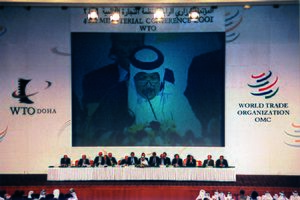
In November 1991, China joined the Asia-Pacific Economic Cooperation. The 1990s saw the peaceful return of Hong Kong and Macau to China. The United Kingdom returned Hong Kong, and Portugal returned Macau. Hong Kong and Macau mostly kept their own governments. They kept their independent economic, social, and legal systems until 2019. At that time, Beijing tried to increase its power, leading to large protests in Hong Kong.
Jiang Zemin and Bill Clinton visited each other's countries. But relations between China and the United States became very difficult at the end of the decade. This was especially true after the third Taiwan Strait Crisis. On May 7, 1999, during the Kosovo War, a US aircraft bombed the Chinese embassy in Belgrade. The US government said it was a mistake due to bad information. In the United States, the Cox Report claimed that China had been stealing important US military secrets. In 2001, a US surveillance plane collided with a Chinese fighter jet over international waters near Hainan. This caused more anger among the Chinese public, who were already unhappy with the United States.
After ten years of talks, China was finally allowed into the World Trade Organization in 2001. The same year saw the creation of the Shanghai Cooperation Organisation. In August 2002, thanks to the efforts of the famous mathematician Shiing-Shen Chern, the international meeting for mathematicians was held in Beijing. This was the first time it was held in a developing country.
Major Disasters of the Jiang Era
| Time | Disaster | Location | Deaths | Descriptions |
|---|---|---|---|---|
| 1990 | Guangzhou Baiyun airport collisions | Guangdong | 128 | A hijacked plane led to a collision on the runway. |
| 1992 | Eastern China flood | East China | At least 431 | At least 267 deaths in Anhui and 164 in Jiangsu. Some sources claim over 1,000 deaths. |
| 1992 | Flight 7552 accident | Jiangsu | 106-109 | A China General Aviation plane crash. |
| 1992 | Flight 3943 accident | Guangxi | 141 | A China Southern Airlines plane crash. |
| 1994 | Flight 2303 accident | Shaanxi | 160 | A China Northwest Airlines plane crash. |
| 1994 | Typhoon Fred | Zhejiang | 1,426 | Known as Typhoon 9417 in China. |
| 1994 | Karamay fire | Xinjiang | 325 | A major controversy was that students were told to stay seated so officials could escape first. 288 schoolchildren died. |
| 1996 | Lijiang earthquake | Yunnan | 309 | A magnitude 6.6 earthquake. |
| 1996 | Typhoon Herb | Fujian | 779 | Known as Typhoon 9608 in China. |
| 1997 | Asian financial crisis | Asia | This crisis affected China's economy to some extent. | |
| 1998 | Yangtze River floods | Yangtze River and others | 3,000-4,150 | This was considered the worst flood in Northern China in 40 years. |
| 2001 | Shijiazhuang bombings | Hebei | 108 | |
| 2002 | Flight 6136 accident | Liaoning | 112 | A China Northern Airlines plane crash. |
Hu Jintao and the Fourth Generation (2002–2012)
A New Leader Takes Charge
Hu Jintao became the General Secretary of the Chinese Communist Party in November 2002. This is a very powerful position. In March 2003, Hu Jintao became the 6th President of the People's Republic of China. Wen Jiabao became the Premier of China. In September 2004, Hu Jintao also became the head of the military.
Inside China: Growth and Challenges
The economy continued to grow very quickly, with double-digit numbers. Developing rural areas became a main focus of government policy. In 2010, China became the world's second-largest economy, passing Japan. The Hu Jintao - Wen Jiabao government focused on a "Scientific Perspective" to create a "Socialist Harmonious Society." Some of the excesses from Jiang Zemin's time were slowly reversed. In late 2002, the South–North Water Transfer Project began construction.
To strengthen his power, Hu Jintao removed Shanghai Party secretary Chen Liangyu and other possible political rivals. This happened during efforts to fight corruption and against the powerful "Shanghai clique." In particular, in 2012, the Wang Lijun incident and the scandal of Bo Xilai received a lot of public and media attention.
China's continued economic growth and strong performance in sports led to it hosting the 2008 Summer Olympics. However, this also put Hu Jintao's government under intense scrutiny. While the 2008 Olympics was seen as China's big coming-out party, the government faced criticism because of the March 2008 Tibet protests. The Olympic torch relay faced protests along its route. Inside China, these reactions led to a strong wave of nationalism. People accused the West of being biased against China.
During the worldwide financial crisis that started in the United States, China's economy continued to grow. This increased China's confidence in its way of developing. It also convinced leaders that the global balance of power was changing. China believed the crisis was caused by Western countries' "wrong economic policies" and "unsustainable ways of development." When Western countries faced financial disaster, China provided money for infrastructure projects. This helped stabilize the global economy and gave China a chance to improve its own infrastructure. China's standing as a responsible global player grew during the crisis.
Meanwhile, many scientific advances and breakthroughs happened between 2002 and 2012. Many came from the 863 Program. In 2003, China successfully sent an astronaut, Yang Liwei, into space with Shenzhou 5. This made China the third country to do so independently, after the United States and the Soviet Union. In 2010, Jiaolong, China's manned deep-sea research submersible, was used. In 2011–2012, BeiDou-2, China's satellite navigation system, started working. In 2011, Tiangong-1, China's first prototype space station, was successfully launched. In March 2012, results from the Daya Bay Reactor Neutrino Experiment in Shenzhen gained international attention. In October 2012, Mo Yan became the first Chinese citizen from mainland China to win the Nobel Prize in Literature.
Foreign Relations
China's role in the war on terror brought the country closer to the United States diplomatically. In 2010, the Asian Games were held in Guangzhou. In 2011, the Summer Universiade was held in Shenzhen. In 2010, another international event took place in China— Shanghai hosted the World Expo for the first time.
The political status and future of Taiwan remain uncertain. However, steps have been taken to improve relations between the Communist Party and some of Taiwan's parties. These parties have a less hostile view towards China, especially the former rival Kuomintang.
Critics of Hu say that his government was too aggressive in showing its new power. They say it overestimated its reach and angered many neighbors, including countries in Southeast Asia, India, and Japan. Such policies are also said to have provoked the United States.
Major Disasters of the Hu Era
| Time | Disaster | Location | Deaths | Descriptions |
|---|---|---|---|---|
| 2003 | SARS epidemic | Nationwide | 349 (mainland China) | SARS killed 774 people globally, with 349 in mainland China and 299 in Hong Kong. |
| 2005 | Sunjiawan mine disaster | Liaoning | 214 | |
| 2005 | Shalan Town flood | Heilongjiang | 117 | 105 students were killed. |
| 2007-2008 | Financial crisis | Global | This global crisis affected China's economy to some extent. | |
| 2008 | Chinese winter storms | Southern and central China | At least 129 | |
| 2008 | Zibo train collision | Shandong | 72 | 416 people were injured. |
| 2008 | Sichuan earthquake | Sichuan | 69,227 | A very strong earthquake with a magnitude of 8.0. |
| 2008 | South China floods | South China | Over 200 | Severe flooding in several provinces, with dozens of deaths and over a million people forced to leave their homes. |
| 2008 | Shanxi mudslide | Shanxi | 277 | 4 people went missing. |
| 2009 | Heilongjiang mine explosion | Heilongjiang | 108 | |
| 2010 | Yushu earthquake | Qinghai | 2,698 | 270 people went missing. |
| 2010 | China floods | Nationwide | 3,185 | 1060 people went missing. |
| 2010 | Gansu mudslide | Gansu | 1,557 | |
| 2012 | Beijing flood | Beijing | 79 |
Xi Jinping and the Fifth Generation (2012–Present)
A New Leader Takes Over
Xi Jinping became the General Secretary of the Chinese Communist Party and the head of the military on November 15, 2012. These are the two most powerful positions. On March 14, 2013, he became the 7th President of China. Li Keqiang became the Premier of China in March 2013.
In October 2022, Xi Jinping was re-elected as General Secretary for a third term. This was a first since Mao Zedong's death.
Inside China: Power and Progress
A huge, long-term anti-corruption campaign has been ongoing since 2012. It has mostly targeted Xi Jinping's political rivals.
In March 2018, the Party-controlled National People's Congress approved changes to the constitution. These changes removed term limits for the president and vice president. They also created a new National Supervisory Commission and strengthened the Communist Party's central role. On March 17, 2018, Xi Jinping was re-appointed as president, now without term limits. Xi Jinping explained that this was needed to match the other powerful posts he held, which had no term limits.
On the other hand, a series of scientific advances took place. In 2013, the Yutu rover was successfully sent to the Moon. This happened after the Chang'e 3 lander landed there. In 2015, Tu Youyou became the first Chinese citizen from mainland China to win the Nobel Prize in Physiology or Medicine. In December 2015, the Dark Matter Particle Explorer, China's first space observatory, was successfully launched. The Tiangong-2 space laboratory was successfully launched in 2016. In the same year, the Five-hundred-meter Aperture Spherical Telescope (FAST) was built in Guizhou. In 2018, the Hong Kong–Zhuhai–Macau Bridge, the world's longest sea-crossing bridge, opened to the public.
Foreign Relations
As Xi Jinping gained more power in China, he slowly moved away from Deng Xiaoping's diplomatic rules. These rules were to "hide your strength, bide your time, never take the lead." Xi appeared more as a "strongman" on the global stage. He launched the "One Belt One Road initiative." This plan involves investing in infrastructure in many countries. It has received a lot of attention, both positive and negative.
Since Xi Jinping became leader, he has tried to change China's "passive" approach. He now uses a more assertive strategy to defend China's claims over border and territory disputes. These include areas like the South China Sea and Taiwan. In 2018, the China–United States trade war started. This greatly affected the global economy. In May 2020, conflicts between China and India broke out along the border, resulting in casualties.
On the other hand, after Xi Jinping came to power, many international summits were held in China. In 2014, the 22nd annual meeting of Asia-Pacific Economic Cooperation (APEC) leaders was held in Beijing. In 2016, the G20 summit was held in Hangzhou. In 2017, the 9th BRICS summit was held in Xiamen. Additionally, in 2015, the Ma–Xi meeting in Singapore was the first meeting between the political leaders from both sides of the Taiwan Strait since the end of the Chinese Civil War in 1950.
China refused to condemn the Russian invasion of Ukraine. It repeated Russian information about the war. It also opposed economic sanctions against Russia. China either did not vote or sided with Russia in UN votes about the war in Ukraine.
Major Disasters of the Xi Era
| Time | Disaster | Location | Death | Descriptions |
|---|---|---|---|---|
| 2013 | Lushan earthquake | Sichuan | Over 200 | A magnitude 7.0 earthquake. |
| 2014 | Kunshan explosion | Jiangsu | 146 | 114 people were injured. |
| 2014 | Ludian earthquake | Yunnan | At least 617 | A magnitude 6.5 earthquake. |
| 2015 | Sinking of Dongfang zhi Xing | Hubei | At least 442 | On June 1, 2015, a river cruise ship with 454 people on board capsized. |
| 2015 | Tianjin explosions | Tianjin | 173 | 798 people were injured. |
| 2015 | Shenzhen landslide | Guangdong | At least 73 | 4 people went missing. |
| 2016 | China floods | Yangtze River and others | At least 449 | |
| 2016 | Jiangsu tornado | Jiangsu | 99 | 846 people were injured. |
| 2019 | Xiangshui chemical plant explosion | Jiangsu | 78 | 617 people were injured. |
| 2019–present | COVID-19 pandemic | Global | Ongoing | In December 2019, a new virus caused an outbreak in Wuhan, Hubei. On March 11, 2020, the World Health Organization declared COVID-19 a worldwide pandemic. |
| 2020 | China floods | Southern China | 219 | 63.46 million people were affected. |
| 2021 | Henan floods | Henan | 398 | |
| 2022 | Flight 5735 accident | Guangxi | 132 |
Images for kids
-
Red Guards on Tiananmen Square during the Cultural Revolution (1967).
-
The image of Deng Xiaoping in Shenzhen.
-
Zhuhai, one of the first special economic zones of China.
-
Zhao Ziyang, a leading reformist, was assigned by Deng to take charge of the political reforms since 1986. However, he was forced to leave his position as the General Secretary of CCP after the 1989 Tiananmen Square protests and massacre, while the majority of the planned political reforms (after 1986) ended drastically.
-
The 1989 Tiananmen Square protests, which was ended by a military-led massacre.
-
Deng Xiaoping and Jimmy Carter in 1979.
-
On 10 November 2001, the Ministerial Conference of the World Trade Organization (WTO) in Doha approved China's entry into the WTO.
See also
 In Spanish: Historia de la República Popular China para niños
In Spanish: Historia de la República Popular China para niños
- History of China
- History of the Republic of China
- History of Hong Kong
- History of Macau
- Dynasties in Chinese History
- Economic History of China
- Foreign relations of China
- History of foreign relations of China
- Historiography of China
- History of Chinese Art
- History of education in China
- History of science and technology in China
- Legal History of China
- Linguistic History of China
- Military history of China
- Naval history of China
- Timeline of Chinese history



